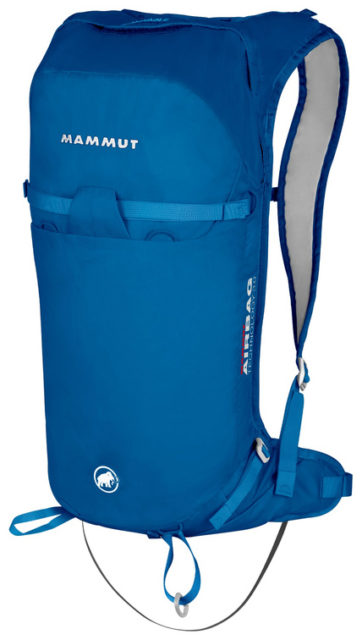
Mammut Ultralight Removable Airbag 3.0
Available Sizes: One Size (~19” torso length)
Materials:
- Body fabric: 100-denier Cordura Ripstop Nylon
- Base fabric: 210-denier Cordura Nylon
Stated Weight:
- Pack (without airbag system): 500 grams
- Removable Airbag 3.0 system: 700 grams
- Cartridges: 310 – 700 grams (depending on country and material)
- Total System: 1510 – 1900 grams (depending on the cartridge)
Blister’s Measured Weight:
- Pack (without airbag system): 551 grams
- Removable Airbag 3.0 system: 691 grams
- Cartridge — European, steel (filled): 518 grams
- Cartridge — North American, aluminum (filled): 695 grams
- Total System: 1760 grams (Euro cartridge); 1937 grams (North American cartridge)
Stated Volume: 20 Liters
Stated Features:
- Removable Airbag System 3.0: ultra-lightweight (with carbon cartridge approx.1 kg); very small packing volume; removable and transferable; dependable compressed gas energy storage; height-adjustable deployment handle; airbag balloon in bright signal color
- Diagonal ski carrier
- Ice ax / trekking pole holder
- Lateral compression straps
- Full rear zipper access to the main compartment
- Hydration system-compatible
- Removable back padding can be used as cushion to sit on
MSRP: $489 (not including cartridge)
Test Locations: Alta & Grizzly Gulch, UT; Front Range, CO
Days Tested: ~10
Intro
Avalanche airbags can provide significant safety benefits for those traveling in avalanche terrain, but lots of us are still coming up with excuses for not using them (myself included). For many, it comes down to two primary objections: (1) they’re too expensive and / or (2) they’re too heavy.
But the Mammut Ultralight Removable Airbag 3.0 (aka, Ultralight RAS 3.0) aims to address both of those issues. Weighing it at less than 2000 grams for the entire system (pack, airbag, and full canister) and retailing at less than $500 USD, the Ultralight RAS 3.0 seems to solve both of those problems.
So is this pack truly the solution for anyone looking for an avalanche airbag?
Blister reviewer Paul Forward and I have both spent time using the Ultralight RAS 3.0, and here’s what we’ve found.
Fit
The Ultralight Removable Airbag 3.0 only comes in one size and does not have a frame, and instead includes a removable foam sheet for support. This makes the Ultralight RAS 3.0 pretty versatile when it comes to fit.
The Ultralight RAS 3.0’s torso is not very long and I’ve spoken to people as short as about 5’4” who haven’t had issues adjusting it to fit their frames. I’m 5’10”, 140 lbs and this pack fits me well, and Paul, who’s 6’, says the pack also fits him pretty well. The Ultralight RAS 3.0 is so small and minimal that I would be surprised if many people had fit issues (as opposed to packs with sturdy frames, where an improper fit is more noticeable). If you are taller than 6’3” or under about 5’3”, I’d recommend trying on the Ultralight RAS 3.0 just to make sure it works for you.
The Ultralight RAS 3.0 has very small padded “wings” on the hip belt, so if you have a small waist those wings will help make the hip belt a bit more comfortable. But for anyone with a waist larger than about 31”, the wings don’t do much since they don’t extend very far along the hip belt. That said, this is a minimal pack with only 20L of stated volume, so it’s not meant to carry heavy loads. And on the note of volume…
Volume
Mammut says the Ultralight Removable Airbag 3.0 has 20 liters of internal volume, but we think that number is quite generous. Perhaps it’s because the only way to access the inside of the pack is through the back panel, or because the airbag mechanism is awkward and difficult to pack around, or maybe it’s because the pack really doesn’t have a full 20 liters of space. Whatever it is, this pack feels very small for its stated volume.
I am lucky enough to have a Euro-style steel canister left over from my time spent overseas, and this canister is significantly smaller than the refillable North American aluminum canisters (the two are similar in diameter, but the Euro canister is 20 cm long, while the North American canister is 33 cm long and has a bulky pressure gauge). This small amount of extra volume gained by the more minimal steel canister is an important qualifier to keep in mind when I talk about how much I can fit in this pack. Those using the larger aluminum canisters will have a bit less usable volume inside the pack.

Another important note is that it takes some skill and experience to efficiently pack the Ultralight RAS 3.0. My initial frustration with the size of the pack ebbed away to just a slight annoyance after about 4-5 tours worth of packing practice, and I feel like I really got it dialed after about 10 tours. The more and more I’ve used this pack, the more gear I’ve been able to fit inside it.
I can fit a full kit for a day of touring in the Ultralight RAS 3.0 with the Euro-style canister. That includes the following:
- Shovel (Black Diamond Deploy 7)
- Probe (Black Diamond Super Tour 265)
- Patagonia Micro Puff Hoody
- Hat
- Small first aid kit
- Goggles
- Midweight non-gauntlet gloves
- Skins cut for the 189 cm Scott Scrapper 115
- 1.5 liters of water (in a soft bottle)
- 1-2 bars
- An Outdoor Tech Yowie
I’m pretty sure I could make this kit work with the larger aluminum canister too, but a shovel blade presents some difficulties — I haven’t yet figured out a good way to make it fit with the larger canister.
While I can fit pretty much everything I need in the pack, it’s still very difficult to pack the Ultralight RAS 3.0 with all that stuff and equally difficult to access it all once it’s been packed up.
But it’s important to remember that the Ultralight RAS 3.0 is a minimalist pack. This pack isn’t about ease of use, it’s about a streamlined feature set and removing any features that aren’t absolutely necessary in order to cut weight and allow you to move faster in the mountains. This is a tradeoff you often have to make with a lot of ultralight gear.
Pockets
The Ultralight Removable Airbag 3.0 doesn’t have any pockets or separate compartments. It has one main compartment that holds the airbag pouch (most of the airbag and mechanism is contained in a separate mesh bag) and all of your gear, which is accessed through a lone back panel zipper.
And this means that, with the Ultralight RAS 3.0, you have to store all your avalanche gear in the same compartment as the rest of your gear. This makes packing the bag efficiently even more important, so that you know you can have quick access to your avy gear if needed.
Other Features
There are very few features on the Ultralight Removable Airbag 3.0. It has a thin strap that goes across the top of the pack which works as both a compression strap and, when combined with the ski tail holster at the bottom of the pack, a diagonal ski carry system.
The Ultralight RAS 3.0 has a small loop on the bottom of the pack that can hold an ice tool or ice ax. If your tools have low-profile heads, you might be able to fit two tools through this loop. The ski strap can also be adjusted to accommodate another tool, but then you’re obviously left without a diagonal ski carry strap. Lastly, the foam in the back panel of the Ultralight RAS 3.0 can be removed and used as a seat cushion.
Ski Carry
The Ultralight Removable Airbag 3.0’s diagonal ski carry is pretty minimal, and in use, I’d say it’s passable. It certainly isn’t as secure as the burlier options on packs like the Mammut Pro Protection 35L or Scott Backcountry Guide AP 30, but it is a bit better than the ski carry on the Arva Reactor (which holds the skis pretty far off of the back).
The main issue with the Ultralight RAS 3.0’s ski carry is that the pack has so little structure to it, so the security of the ski carry is dependent on how fully packed the bag is, and how effectively packed it is.
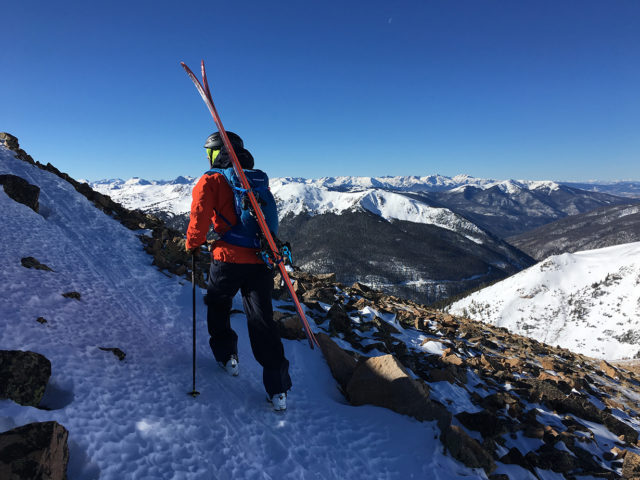
Even when fully packed, the Ultralight RAS 3.0’s ski carry holds the skis a bit loosely and they do tend to move around. Paul reported that he’s been able to make the ski carry a bit more secure by looping a 24” ski strap through the pack’s top grab loop or shoulder strap, which can help bring the skis a bit closer to the body.
I’ve also sliced several holes in the outer fabric of the Ultralight RAS 3.0, which were the result of ski edges rubbing on the pack while I was using the diagonal ski carry. The pack’s outer fabric is not very thick and the way I need to pack my shovel in the pack creates a distinct pressure point on the outside of the pack, which rubs on ski edges.
Removable Airbag 3.0 System
The Mammut Removable Airbag System 3.0 is one of the lightest airbag systems on the market. It’s made mostly of composite materials and has been refined over several iterations. We both agree that the RAS 3.0 is considerably more user-friendly, lighter, and smaller compared to the RAS 2.0.
The RAS 3.0 doesn’t use a reset tool to ready the trigger for activation (the 2.0 system did require a reset tool). This means that with the RAS 3.0, I (1) don’t have to keep track of an easy-to-lose reset tool and (2) don’t have to worry about accidentally screwing in a canister without resetting the system and having the bag (literally) blow up in my face.
The RAS 3.0 does come with a plastic piece that you can screw into the airbag system to practice pulling the trigger, but it isn’t necessary for actually activating the airbag with a canister.
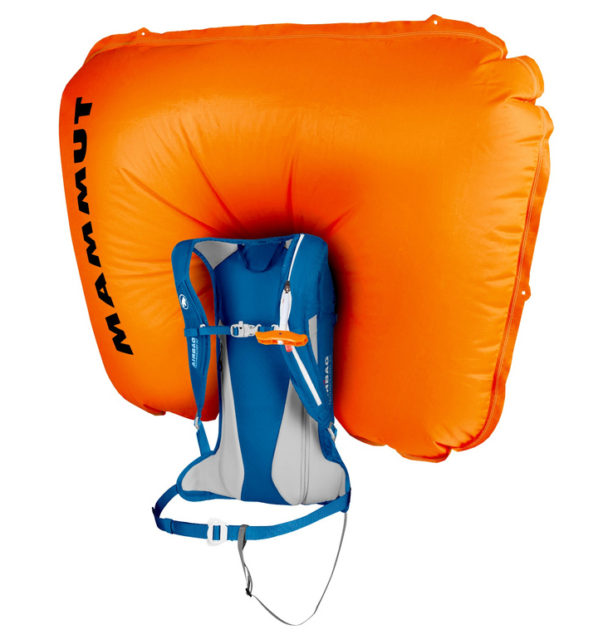
The RAS 3.0 also replaces many of the aluminum parts from the 2.0 system with lighter plastic pieces, which is part of why the 3.0 system weighs a bit less (Mammut claims the RAS 3.0 is 20% lighter and 30% smaller than the previous version).
For reference, below are some stated weights in grams for a few notable airbag systems (entire airbag system + full cartridge or battery). Keep in mind that steel cartridges tend to be roughly around 200 grams heavier than carbon cartridges, and refillable aluminum cartridges tend to be around 300-400 grams heavier than their carbon counterparts. Currently, carbon cartridges are not available in the U.S. and steel cartridges are difficult to come by, so those weight differences become important for people without access to steel or carbon cartridges.
1000 Ortovox Avabag (with carbon cartridge)
1010 Mammut Removable Airbag 3.0 (with carbon cartridge)
1130 Scott Alpride 2.0
1240 Scott Alpride 1.0
1280 Scott Alpride E1
2000 Black Diamond Jetforce
Air Travel
You can fly with any of the Removable Airbag System 3.0 canisters without restriction if they are empty (the hole at the outlet must be visibly punctured). And according to this chart from Mammut, one person can carry on or check one RAS 3.0 bag and one full canister.
However, after being hassled at airports around the world for carrying a variety of airbags (always in my checked bags), I would definitely check with the transportation authority and airline in the country(s) you’ll be traveling to in order to minimize potential issues. If your canister gets confiscated, new ones can be difficult to replace depending on where in the world you happen to be. You can check out this page on Mammut’s site for a list of stores where you can rent, purchase, and / or refill compatible canisters.
Activation / Trigger
The Removable Airbag 3.0 system is activated by a sharp tug on the trigger. This releases a spring-loaded pin that punctures the copper burst disc in the cartridge and releases the compressed air. The RAS 3.0’s trigger function is mechanical, unlike the ABS systems which use a charge in the handle to activate the airbag.
The Ultralight RAS 3.0’s trigger can only be routed through the left shoulder strap and it has three different adjustment positions up and down the shoulder strap.
In Use
The Ultralight Removable Airbag 3.0 is small, light, and very minimal in terms of features and construction. As a result, it’s not the easiest pack to use, and its ease of use is largely stipulated by how well it is packed. After about 10 days using it, I was able to develop a system that allowed me to access the gear I needed, when I needed it. However, it’s still not very easy to pack the Ultralight RAS 3.0 and doing so requires a lot of care and attention to pack everything just right (and to remember exactly where you put it).
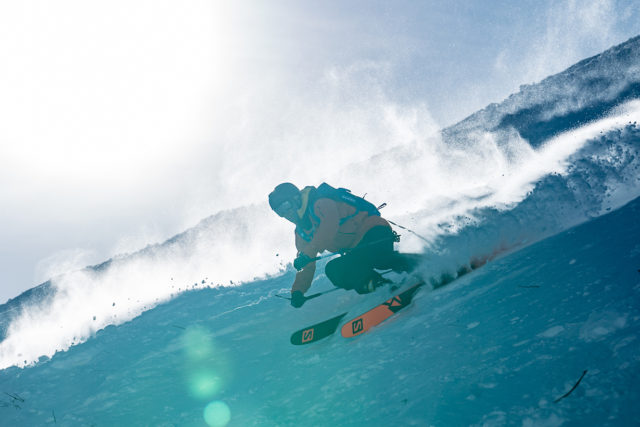
Here are couple random suggestions we’ve come up with while using the Ultralight RAS 3.0:
Storing your water in a soft bottle (e.g., something from Platypus) helps a lot when packing the Ultralight RAS 3.0. A bulkier Nalgene or Klean Kanteen takes up a lot of valuable space.
The size of your shovel is also very important. If your shovel blade is too big, it won’t fit (my Black Diamond Deploy 7 just barely fits). And if your shovel is too small, you won’t get the benefit of the shovel acting as a frame for the pack and creating space by providing structure while packing.
Durability
The Ultralight Removable Airbag 3.0 is just that — ultralight. And its lightweight materials are a big reason behind its low weight. After 10 days of use, I now have several tears in the outer fabric from ski edges rubbing on the pack while using the diagonal ski carry (I’ve since patched them with Tenacious Tape). The zipper pull on the Ultralight RAS 3.0’s back panel opening also broke.
A piece that is built as minimally as the Ultralight RAS 3.0 definitely requires you to be more careful with it to avoid tearing it up in the mountains. That’s one of the big sacrifices that comes with ultralight gear. But if you really want to minimize the weight that you’re taking with you into the backcountry, that’s one of the tradeoffs you’ll need to make.
Who’s It For?
The Ultralight Removable Airbag 3.0 is a very specialized product, so Paul and I both think it makes the most sense for specialized demographics.
First and foremost, you should really only consider this pack if you place a very high priority on low weight, and a lower priority on generous feature sets, durability, and ease of use. If you’re not looking for the lightest airbag out there, then there are plenty of other options that offer many more features, are more durable, and that can carry more gear.
With that in mind, the Ultralight RAS 3.0 could work for a few different types of people.
First, I think it could be a very good sidecountry pack, since in that scenario, you wouldn’t need a ton of volume. Just be careful with the lightweight materials.
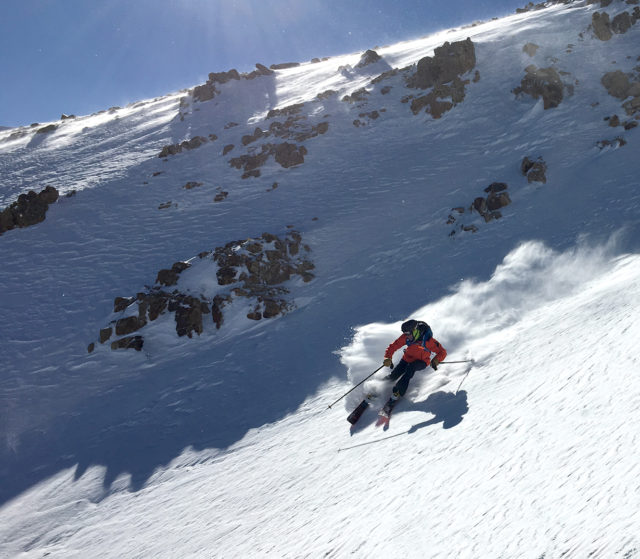
This pack could also be a great choice for people who are using mechanized means to get into the backcountry (e.g., heli, cat, or snowmachine) and therefore don’t need to store all of their stuff in the pack itself.
The Ultralight RAS 3.0 could also work as a dedicated backcountry pack for trips where you’re not taking a lot of gear with you. This could mean shorter day trips, or full days for people that have really dialed in their backcountry kit to make it very light and packable.
Also, if you’re interested in carrying an airbag on bigger ski mountaineering missions for the added safety, the Ultralight RAS 3.0 comes in at a reasonable weight for long days in the mountains. Just understand that you’ll have to strip down your kit to the bare essentials to get everything to fit, and the Ultralight RAS 3.0 doesn’t have many of the climbing-oriented features of heavier packs.
Lastly, snowboarders that are looking for a really low profile pack that won’t snag as easily on trees, rocks, etc. while going sideways through tight spots might appreciate the Ultralight RAS 3.0. This pack sits very close to your body and is barely noticeable while skiing, snowboarding, or sledding compared to most other airbag packs.
Bottom Line
The Mammut Ultralight Removable Airbag 3.0 lives up to its name — it truly is “ultralight.” It uses one of the lightest airbag systems on the market, and when paired with its very stripped-down and nearly featureless silhouette, the Ultralight RAS 3.0 is one of the lightest airbag packs currently available. But with that scant weight come sacrifices in terms of ease of use, versatility, and durability. The Removable Airbag System 3.0 itself is light and intuitive to use, but I think many backcountry travelers will want a more feature-rich pack to pair with it (and the good news is that Mammut makes many other packs that are compatible with the RAS 3.0 system).

You say this pack isn’t about ease of use, but about saving weigh. I could see that as valid regarding adding extra zippers and organizers, but I don’t agree in regards to volume. Making the pack a bit bigger, would only add a very minimal amount of weight, yet make using the pack much easier(I imagine).
So there are a lot of options from Mammut and others if you are just wanting a bigger pack. There are also carbon canisters which I use for further weight savings. In my family there is one biggest pack which I ski with and I carry a lot of stuff. My kids ski with these and generally carry water, goggles, a layer and little else. As noted this is a great option if helis are involved….that is where I tend to see this pack often and in Europe you see it a lot. I haven’t seen a better option yet for that purpose.
If you aren’t wearing an avi pack in the backcountry because of weight – well shoot….that’s not a valid reason anymore. Please give a long think to using one if you can afford one, they work.
Great pack. Been using for 2 years and love it. As per the review ski carry is a bit tricky with big powder skis and there are plenty of resulting abrasion marks on the outer material but it’s still going strong and the light weight when using is a joy. No problem to get a days gear inside.